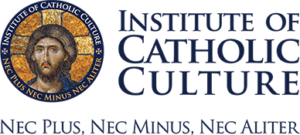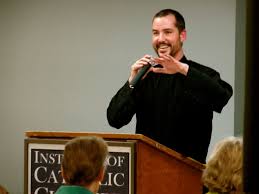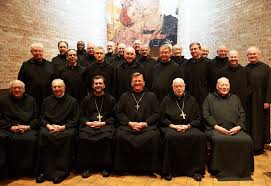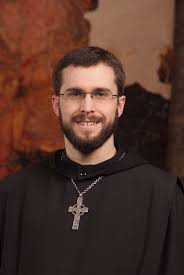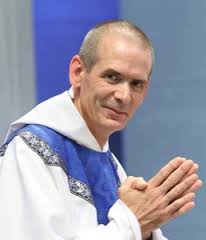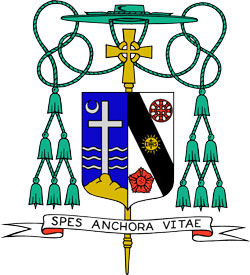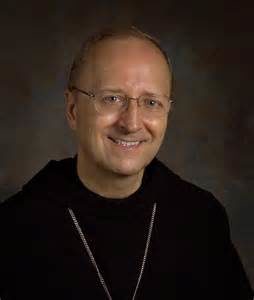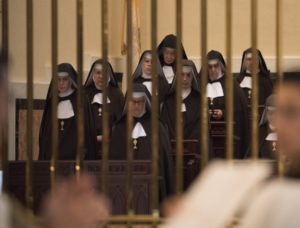Mother Therese M. of Jesus Crucified, OCD, of the Carmelite Monastery of Rochester in Pittsford, NY, sent us an article way back in April about her trip to Rome for the closing Mass of the Year of Consecrated Life. She came back with new insights into Founders of other contemplative orders, for as she says, ” I felt that I met each Founder of these contemplative Orders by being with their daughters who were present.” In addition, she received an understanding of the importance of the religious habit, as coming from the charismatic inspiration of the founder as well. Here is the article, long overdue! (My fault, Mother!)
Roman Momentos by Mother M. Therese of Jesus Crucified, OCD
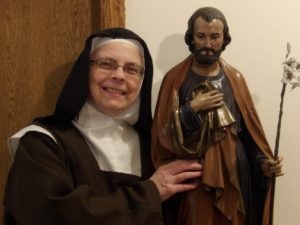 It is a simple teaching of good manners that eavesdropping is impolite. One should do everything possible to ignore what is unintentionally overheard, and should never repeat it. When one is in a dense crowd of people on every side, it is not always easy to “ignore” what is being said by those right behind you and practically in your ear! During my recent stay in Rome with thousands of other consecrated persons for the closing of the Year of Consecrated Life, I often found myself in a dense (almost suffocating) crowd of mostly nuns. One occasion particularly stands out in my memory because it was accompanied by a profound insight – a kind of word from the Lord. To me, sharing this occasion with other religious merits breaking the rules of good manners. After reading this account you can be the judge of good or bad manners!
It is a simple teaching of good manners that eavesdropping is impolite. One should do everything possible to ignore what is unintentionally overheard, and should never repeat it. When one is in a dense crowd of people on every side, it is not always easy to “ignore” what is being said by those right behind you and practically in your ear! During my recent stay in Rome with thousands of other consecrated persons for the closing of the Year of Consecrated Life, I often found myself in a dense (almost suffocating) crowd of mostly nuns. One occasion particularly stands out in my memory because it was accompanied by a profound insight – a kind of word from the Lord. To me, sharing this occasion with other religious merits breaking the rules of good manners. After reading this account you can be the judge of good or bad manners!
One of the most beautiful and unforgettable experiences that I had in Rome was to see hundreds of contemplative nuns – there were over 400 of us—brought together by the invitation of the Congregation for Institutes of Consecrated Life and Societies of Apostolic Life. Of course, it was impossible to meet each one personally. Yet, I felt that I met each Founder of these contemplative Orders by being with their daughters who were present. Each nun and her religious family were identifiable by their distinctive religious habit. For me, it was breathtaking to spot Benedictines, Dominicans, Cistercians, Poor Clares, Brigittines, Visitandines, Servites, Adorers of the Precious Blood, as well as over 100 of our beloved Carmelites! A history of holiness was encountered by just seeing the beautiful sign of the religious habit.
Of course, the religious habit needs to be kept in proper perspective remembering the old adage: “The habit does not make the monk” (or the nun)! St. Teresa of Jesus wisely makes the same point: “We seem to think that everything is done when we willingly take and wear the religious habit…” (Int. Cast. III, 1, n. 8) By no means! The habit is not an end in itself, but it is a powerful witness! It is an outward sign of an inward grace. Just as in baptism we “put on Christ”, we are clothed “as new men”, to use the expressions of St. Paul, and this is beautifully signified by the white garment worn by the newly baptized, so consecrated religious are clothed in the garb of their religious family as a sign of their share in the grace of the Founder’s charism and of their identity as members of the family. The Lord made this sign hit home even more wonderfully by another unexpected encounter.
My Carmelite companion, Sr. Gabriela, and I arrived around 3:00pm at the area of the Colonnade of St. Peter’s in what we thought was plenty of time for the 5:30pm Mass of the Holy Father on Feb. 2nd the Feast of the Presentation. We got on the end of the line to go through security. After a few minutes we realized that the beginning of the line was clear across the other side of the Colonnade! We had a long wait and a long line of people, mainly religious, moved very slowly. By about 4:30 we were three-quarters of the way closer to the security booths. It was then I noticed a rather tall Sister, in a white and blue habit, not in line with the rest of us but standing several feet away and chatting with a seminarian. It was Mother Agnes Mary Donovan of the Sisters of Life from New York. I never personally met Mother Agnes, but I heard much about her. Our Community met several of the Sisters of Life last year when they visited our Carmel in Rochester.
When Mother finished her conversation with the seminarian, I called her and she happily came over to Sr. Gabriela and I. We introduced ourselves to her and warmly met each other as if we were old friends. With a very Irish twinkle in her eyes she asked, “Can I slip into the line with you?” We were delighted that she joined us. As the line inched forward, we enjoyed such a pleasant conversation with her about our days in Rome. She was very interested in the meetings among the contemplative nuns. For herself, she was in Rome with the other members of the Board of the Council of Major Superiors of Women Religious. Mother Agnes chairs the Council and they decided to hold their annual Board meeting in Rome to celebrate together the closing of the Year of Consecrated Life. After a lively 15 or 20 minute exchange with Mother, she noticed other nuns in the line whom she knew and began chatting with them as well. As the line moved under the Colonnade it became narrower and soon Mother Agnes was behind us speaking with two Colletine Poor Clares also from the US. My eavesdropping began shortly thereafter!
At the outset I did not hear anything of Mother Agnes’ conversation with the two Poor Clares, though at one point I heard this American sisterly trio praying the Chaplet of Divine Mercy. A few moments later, it was as if someone put a speaker at my ear. One of the Poor Clares said to Mother Agnes: “That really is a lovely habit you have.” “Yes, it is” she answered and then began to recount the story of how the habit of the Sisters of Life originated. In the early days of the foundation, the first Sisters of Life wore a habit that did not at all satisfy their founding Father, Cardinal John O’Connor of New York. He told them: “We need to think about this” but the Sisters assured him that the habit they had was good enough. He did not want to press the matter, so he let it go. A while later, he again said to the Sisters that he thought the habit should be something else and needed rethinking. Again, the Sisters expressed that they were satisfied with what they were already wearing. Again, he let it go. Another time the Cardinal approached the Sisters again about the habit and he said: “We really need to rethink this.” Then it occurred to Mother Agnes that this is the Founder and if he is saying such a thing he must have an inspiration about what the habit should look like. So the habit was redone according to that inspired idea. At that moment, it was as if the speaker at my ear was turned off, and I heard no more of the conversation.
I was left in total wonderment and wanted to stop everything and relish what I just heard. I thought to myself: “This is amazing! This isn’t an anecdote from some yellow parchment of the Middle Ages, this is contemporary, from our own time and in our own American homeland!” I was impressed in a new way with the realization that even the religious habit comes from the charismatic inspiration of the Founder. Our Holy Mother St. Teresa came to mind. Certainly, the habit of Carmel was refashioned by her charismatic inspiration. It was simplified according to her inspired idea for the renewed way of life of the Discalced and this was spelled out in her Constitutions. Then along with our Holy Mother a whole procession of Founders came before my mind all with their distinctive religious habits which are so expressive of the particular way of life they established in the Church under God’s inspiration: St. Benedict, St. Robert of Solesmes, St. Bruno, St. Francis, St. Dominic, St. Bridget, the first Hermits of Mount Carmel, St. Francis de Sales with St. Jeanne Frances de Chantal, St. Paul of the Cross, soon-to-be St. Teresa of Calcutta and Cardinal John O’Connor with his Sisters of Life.
With renewed love, reverence and gratitude for our own Discalced Carmelite habit, I headed for the security booth.
Carmelite Monastery of Rochester / www.carmelitesofrochester.org / ocdsecretary@gmail.com
Like this:
Like Loading...
 The sisters of the Holy Family will opening the celebration of their 175th Jubilee with a Mass on November 19, 2016, honoring the their foundress Ven. Henriette Delille.
The sisters of the Holy Family will opening the celebration of their 175th Jubilee with a Mass on November 19, 2016, honoring the their foundress Ven. Henriette Delille.